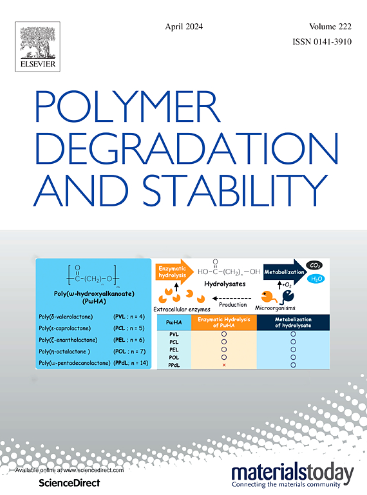The impact of heat and humidity on unplasticized poly(vinyl chloride)
IF 6.3
2区 化学
Q1 POLYMER SCIENCE
引用次数: 0
Abstract
The thermal degradation at 60 °C and 80 °C of unplasticized poly(vinyl chloride), PVC, was comprehensively investigated through the application of numerous spectroscopic techniques, as well as contact angle measurements (CA), dynamic mechanical analysis (DMA), and size-exclusion chromatography (SEC). To study the effect of relative humidity (RH) on the deterioration of unplasticized PVC, two regimes of accelerated degradation experiments were selected: low RH (max. 20 % RH) and high RH = 60 %, which corresponds to usually the highest RH in heritage institutions equipped with an HVAC system. Nuclear magnetic resonance (NMR) analysis revealed no substantial alterations in the material during its degradation for up to 20 weeks. This finding suggests that no significant branching or crosslinking occurred, which was confirmed by SEC measurements. Notable changes were observed in the Raman and UV–Vis spectra, indicative of the formation of conjugated carbon-carbon double bonds through dehydrochlorination. The formation of polyenes was responsible for the yellowing of samples, characterized with a CIELab color analyzer. Notwithstanding, the aforementioned changes did not lead to a notable decline in the mechanical properties, as evidenced by DMA measurements. Electron paramagnetic resonance (EPR) spectroscopy demonstrated the formation of stable radicals even at 60 °C, and in the sample degraded at 80 °C the presence of radicals was evident. This indicates that a radical degradation mechanism cannot be excluded even at such low temperatures, prevailing at higher relative humidity values. A summary of employed methods was prepared as a guideline for heritage scientists, considering the invasiveness and destructiveness of the techniques and their outcomes.
热、湿度对未增塑聚氯乙烯的影响
通过应用多种光谱技术、接触角测量(CA)、动态力学分析(DMA)和粒径排除色谱(SEC),全面研究了未增塑型聚氯乙烯(PVC)在60°C和80°C下的热降解。为了研究相对湿度(RH)对未增塑PVC降解的影响,选择了两种加速降解实验:低相对湿度(max;20% RH)和高RH = 60%,这通常对应于配备暖通空调系统的文物机构的最高RH。核磁共振(NMR)分析显示,在长达20周的降解过程中,材料没有实质性的变化。这一发现表明没有明显的分支或交联发生,这是由SEC测量证实。在拉曼光谱和紫外-可见光谱中观察到明显的变化,表明通过脱氢氯化形成了共轭碳-碳双键。多烯的形成是导致样品变黄的原因,用CIELab颜色分析仪进行了表征。尽管如此,正如DMA测量所证明的那样,上述变化并没有导致机械性能的显著下降。电子顺磁共振(EPR)谱显示,即使在60℃下也能形成稳定的自由基,而在80℃降解的样品中,自由基的存在是明显的。这表明,即使在如此低的温度下,在较高的相对湿度值下,也不能排除自由基降解机制。考虑到技术的侵入性和破坏性及其结果,为遗产科学家准备了一份所用方法的总结,作为指导方针。
本文章由计算机程序翻译,如有差异,请以英文原文为准。
求助全文
约1分钟内获得全文
求助全文
来源期刊

Polymer Degradation and Stability
化学-高分子科学
CiteScore
10.10
自引率
10.20%
发文量
325
审稿时长
23 days
期刊介绍:
Polymer Degradation and Stability deals with the degradation reactions and their control which are a major preoccupation of practitioners of the many and diverse aspects of modern polymer technology.
Deteriorative reactions occur during processing, when polymers are subjected to heat, oxygen and mechanical stress, and during the useful life of the materials when oxygen and sunlight are the most important degradative agencies. In more specialised applications, degradation may be induced by high energy radiation, ozone, atmospheric pollutants, mechanical stress, biological action, hydrolysis and many other influences. The mechanisms of these reactions and stabilisation processes must be understood if the technology and application of polymers are to continue to advance. The reporting of investigations of this kind is therefore a major function of this journal.
However there are also new developments in polymer technology in which degradation processes find positive applications. For example, photodegradable plastics are now available, the recycling of polymeric products will become increasingly important, degradation and combustion studies are involved in the definition of the fire hazards which are associated with polymeric materials and the microelectronics industry is vitally dependent upon polymer degradation in the manufacture of its circuitry. Polymer properties may also be improved by processes like curing and grafting, the chemistry of which can be closely related to that which causes physical deterioration in other circumstances.
 求助内容:
求助内容: 应助结果提醒方式:
应助结果提醒方式:


